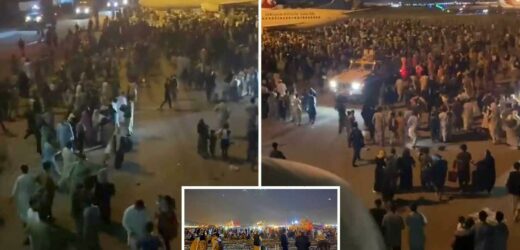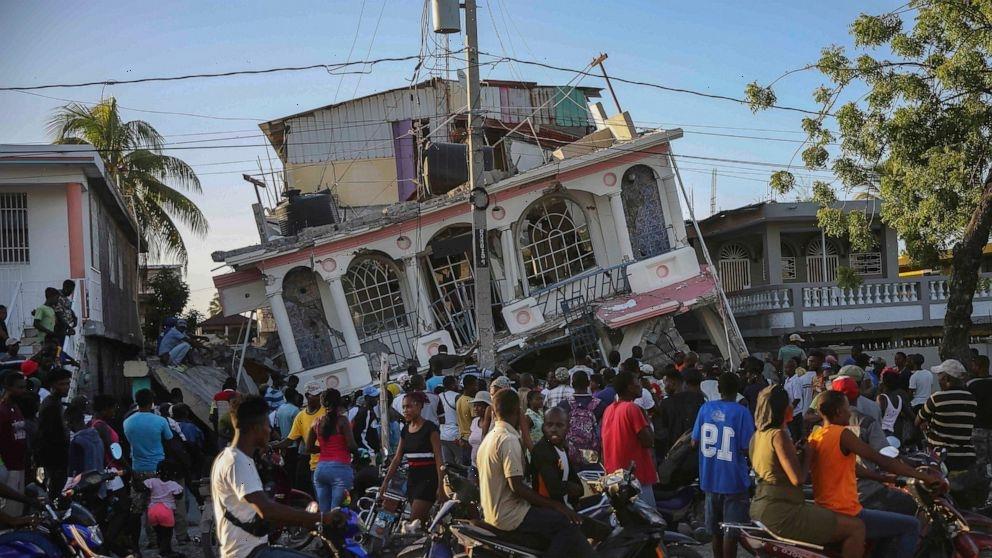A STAMPEDE at Kabul Airport has left five people dead as thousands storm planes in a desperate bid to flee Afghanistan.
In chaotic scenes echoing the fall of Saigon at the end of the Vietnam war, petrified men, women and children were filmed trying to get on aircraft after the Taliban stormed the capital
Desperate people were filmed trying climb up a ladder to get on a plane while others were seen being pulled on board another aircraft.
One witness said he had seen the bodies of five people being taken to a vehicle at the airport.
Unverified reports and video claimed that two people had fallen several hundred feet to their deaths after being thrown from a C-17 transport aircraft taking off from Kabul airport.
At one stage, US troops guarding the airport were forced to fire shots into the air but it's unclear if those who died were hit by bullets or crushed in the stampede.
At one stage, US Apache helicopter gunships swooped down across a runway to clear desperate people trying to board a transport aircraft.
As the C-17 prepared to take off, hundreds of people were seen running behind it in an effort to get on board.
Residents of Kabul today woke up to their first day under Taliban rule with reports the hardliners were scouring the city looking for military vehicles.
In a bid to flee what they fear will be a return to the Taliban's brutal rule based on an extreme interpretation of Islam, people raced to the airport in a frantic bid to board a flights.
The stampede began on on Sunday night and daylight saw another wave of people swarm to the airport as the exodus continued
Another clip showed what were apparently US embassy staff attempting to flee by pulling each other into a plane while the ramp was being raised.
The shocking scenes in Kabul come as…
- Taliban stormed Afghanistan’s Presidential Palace after ripping through Kabul
- Boris Johnson blamed the US for Afghanistan’s ‘accelerated’ collapse to the Taliban
- Afghan President Ashraf Ghani said he fled to ‘prevent a flood of bloodshed’
- UK ambassador Sir Laurie Bristow to remain at Kabul airport to help Brits leave
And a third video showed over a thousand citizens attempting to board a KamAir flight to Istanbul which can only carry 300 passengers.
Footage showed people pushing and shoving as they make their way through the overpacked aisle of the plane which is already over capacity.
It comes as NATO has revealed that all commercial flights are now suspended from Kabul airport with only military aircraft now allowed to operate.
By Sunday night, members of the Taliban members declared that they had been "victorious" in a statement.
In the live broadcast one insurgent said he had spent eight years in Guantanamo Bay.
Now Boris Johnson has blamed the US for the advancement of the Taliban in Afghanistan, claiming President Biden "accelerated" their control.
The Prime Minister said the "difficult" situation had been exacerbated by the President's decision to withdraw troops from the war-torn country.
Earlier today Afghan President Ashraf Ghani fled the country after the Taliban stormed the capital Kabul and seized his palace.
Mr Ghani later said he left to "prevent a flood of bloodshed".
Ghani, who did not say where he had gone, said he believed "countless patriots would be martyred and the city of Kabul would be destroyed" if he had stayed behind.
Taliban fanatics have released 5,000 prisoners and taken control of Kabul as the government dramatically collapsed on Sunday.
It comes hours after the Taliban took control of Jalalabad and means they now have seized every city in the war-torn country.
Mr Johnson yesterday chaired an emergency Cobra meeting and recalled MPs to Parliament to tackle the crisis.
The speed of the Taliban's victory has shaken the world and came just weeks after troops from the US, UK and other Nato countries left Afghanistan.
A few days ago US officials predicted it would take 30 days for the jihadis to reach Kabul – and 90 to take the city – but they have swept all before themin a terrifying rampage.
Twenty years after they were ejected by the US and its allies in the wake of 9/11 they stand on the brink of being back in power.
Tory MP Tom Tugendhat, chairman of the Commons Foreign Affairs Committee, described the Taliban victory "the biggest single foreign policy disaster" since Suez.
His colleague Johnny Mercer, who fought in the country, said it was "humiliating".
Ghani left Kabul for Tajikistan only 24 hours after he addressed the nation and said he hoped to fight on – but the speed of the Taliban advance left him no option but to flee.
They had demanded his removal as part of talks to ensure a peaceful transition of power when they reached Kabul to avoid an all out assault on the capital.
In scenes that echoed the fall of Saigon helicopters were seen ferrying US embassy staff to safety at a secure area near the airport.
The US Ambassador left in the early evening with the American flag to a new site at the airport.
Britain's ambassador Sir Laurie Bristow remains in Kabul where he is working at the airport to help Brits leave the country.
Paras from the 16 Air Assault Brigade have begun deploying to evacuate Brits from the city as well as about 2,000 Afghan nationals who worked with British forces.
Kabul airport is to remain open for foreigners to leave, the Taliban said, and flights were continuing to operate.
Terrified residents have already begun fleeing in their cars leading to traffic jams, with a huge number of people now massing at the country's borders.
More than 4,000 desperate UK nationals are waiting for a last-ditch airlift.
Whitehall insiders revealed a plan was being drawn up to operate a 770-mile military “shuttle” service to reach the haven of Dubai if commercial airlines become unviable.
The deployment of 600 troops, began at the weekend as part of Operation Pitting, which aims to relocate Brits and Afghans facing Taliban reprisals for helping our forces.
Brit troops have been warned they could be drawn into face-to-face fighting with the Taliban.
AIRLIFT OF BRITS
They were briefed about a series of threats ranging from roadside bombs to suicide bombers and drone attacks.
SAS soldiers will link up with interpreters to secure local intelligence and be briefed by special forces colleagues and MI6 agents already based in Kabul.
Commanders want to avoid fighting but the Paras are deploying with grenade launchers and shoulder-fired anti-tank weapons.
They face the challenge of securing the airhead base at Kabul airport and making sure desperate-to-leave Afghans cannot get access to the evacuating aircraft.
But a major concern for the mission — officially termed Non Combatant Evacuation Operation — is the lack of aviation fuel at the airfield, which could hamper the pace of the airlift.
In addition, there were fears that the Taliban will fire on the airport using the latest US 155mm heavy artillery — which was seized from the Afghan army as they advanced across the country.
Radar to track and trace any in-direct Taliban fire such as mortars, rockets and artillery will also be deployed.
But one Whitehall source told The Sunday Times that the airport “will not hold for more than a few days”.
Mazar-e-Sharif, the capital of Balkh province, and the country’s fourth largest city fell on Saturday night.
Timeline of Taliban victory
April 14 – President Joe Biden announces US troops will withdraw from Afghanistan starting on May 1 and ending on September 11.
May 4 – Taliban fighters launch a major offensive on Afghan forces in southern Helmand and at least six other provinces.
June 7 – Government officials say fighting is raging in 26 of the country's 34 provinces.
June 22 – Taliban fighters launch a series of attacks in the north of the country, far from their traditional strongholds in the south.
July 2 – American troops quietly pull out of their main military base in Afghanistan – Bagram Air Base, ending US involvement in the war.
July 21 – Taliban insurgents control about a half of the country's districts, according to the senior US general, underlining the scale and speed of their advance.
July 25 – US vows to continue to support Afghan troops "in the coming weeks" with intensified airstrikes to help them counter Taliban attacks.
July 26 – The United Nations says nearly 2,400 Afghan civilians were killed or wounded in May and June in escalating violence, the highest number for those months since records started in 2009.
August 6 – Zaranj in the south of the country becomes the first provincial capital to fall to the Taliban in years and many more the ensuing days, including the prized city of Kunduz in the north.
August 13 – Four more provincial capitals fall in a day, including Kandahar, the country's second city and spiritual home of the Taliban. In the west, another key city, Herat, is overrun.
August 14 – The Taliban take the major northern city of Mazar-i-Sharif and, with little resistance, Pul-e-Alam, capital of Logar province just 40 miles south of Kabul.
August 15 – The Taliban take the key eastern city of Jalalabad without a fight, effectively surrounding Kabul.
Source: Read Full Article



















